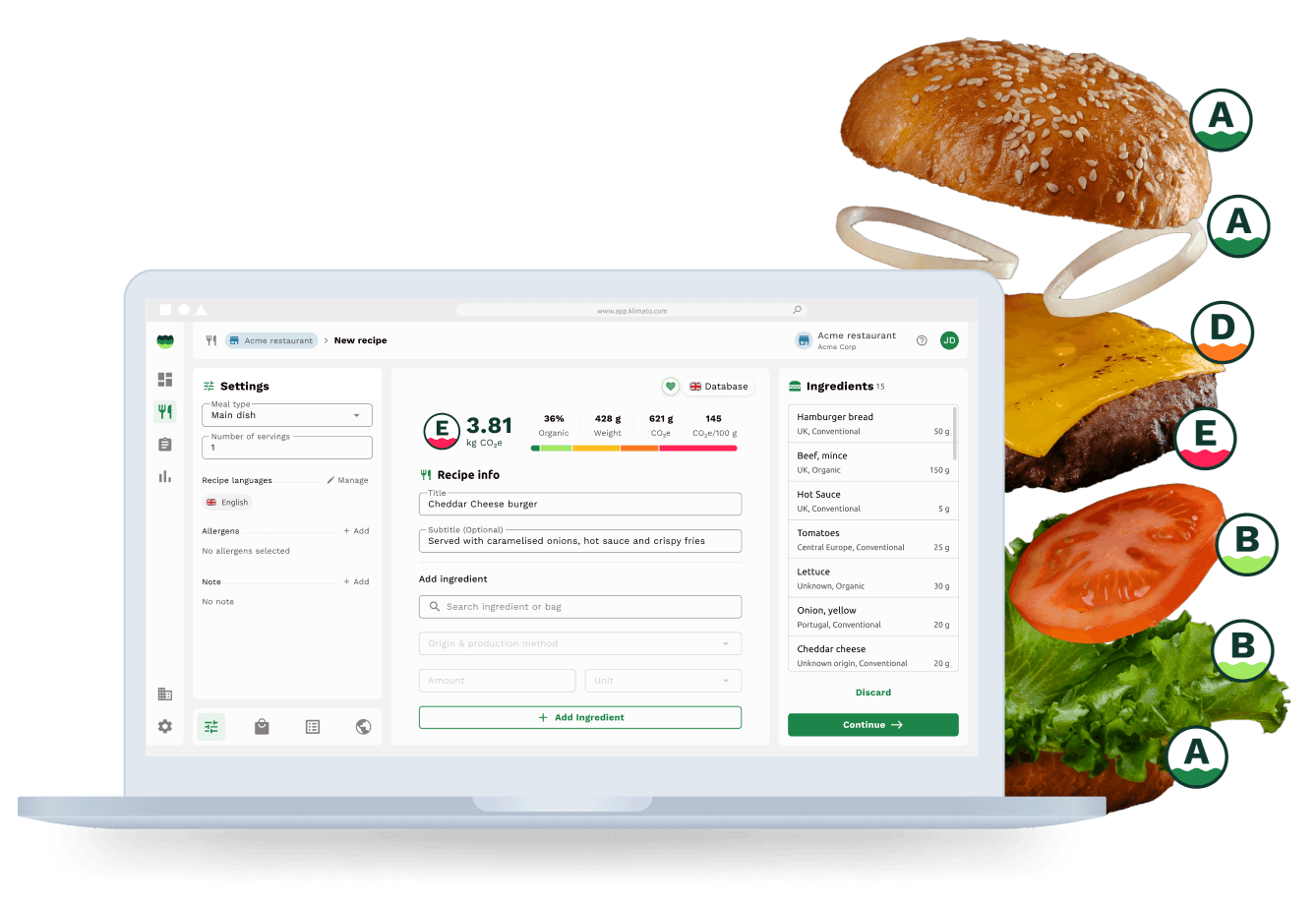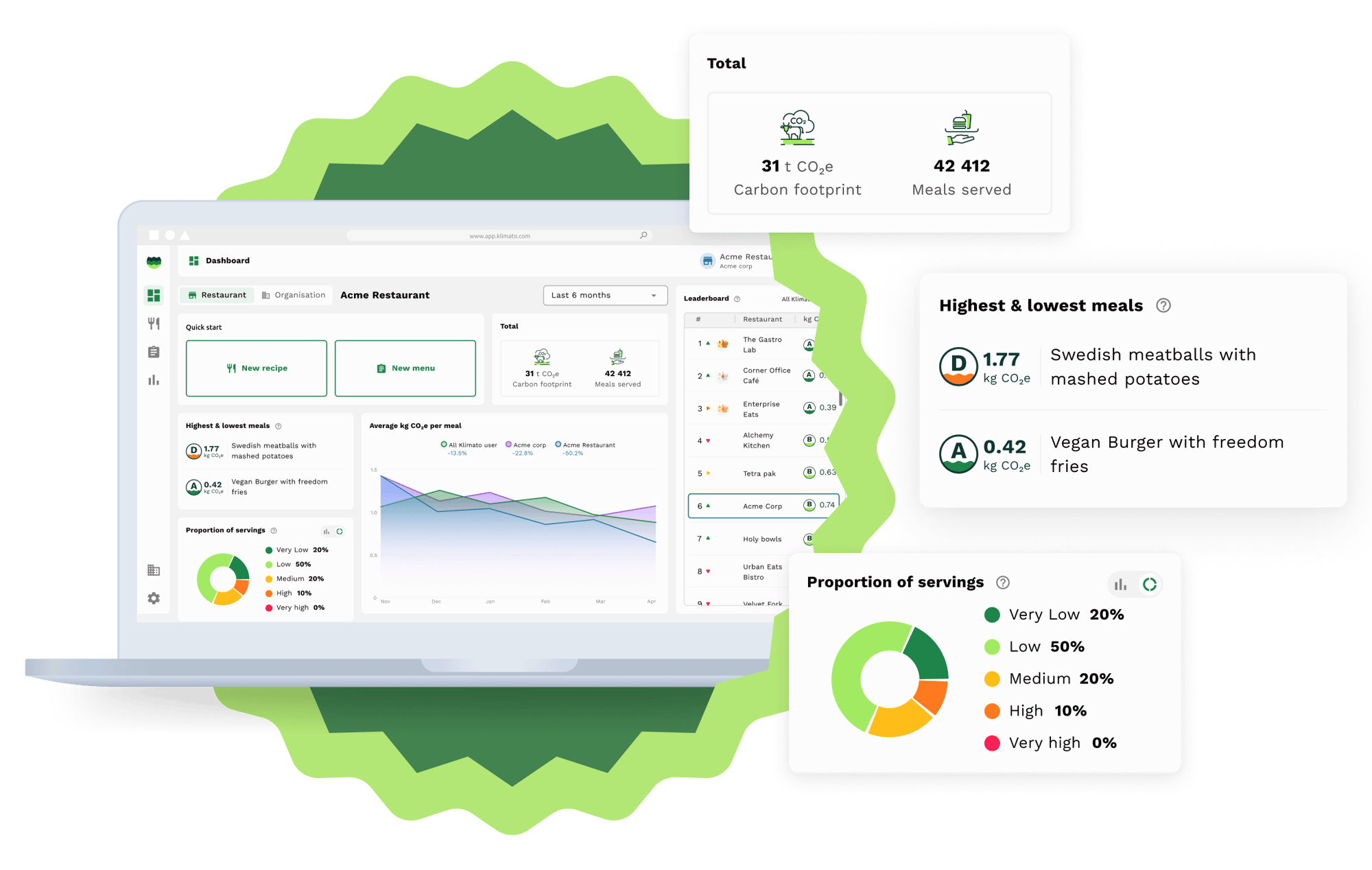
Go beyond sustainability with our Science-Backed data.
Our globally-sourced, local data gives you the tools to make decisions beyond just your emissions. Calculate the impact of your recipes, elevate your brand image for your business and optimize for revenue growth through behavior change.
1. Calculate
Use our tool at any point in your development process to understand the carbon footprint and more of your recipes.
We even integrate with tools you already use to offer a seamless experience.
2. Analyze
Find opportunities in your sustainability data for revenue optimisation through ingredient swaps and scale management.
Klimato gives you the tools to act on both your environmental impact and business need.
3. Label
Use our science-backed data to educate and direct new types of behaviour from your customers.
Use our labels to guide the way for sustainability aligned revenue opportunities while elevating your brand.
4. report
Accurate and compliant reporting is critical to meeting sustainability goals.
Our reports enable you to set goals, reduce emissions and reach both sustainability and revenue targets.
THE NEW STANDARD FOR ENVIRONMENTAL IMPACT CALCUlATION. And your new food superpower.
Meet your sustainability goals
Whether you are on a mission to reach net-zero or find the best ways that your businesses can be more sustainable, Klimato can help. Our eco-tooling removes the barriers in making decisions at every stage of the recipe planning process.
Elevate your branding
Klimato puts you on the map for eco-conscious consumers, builds trust for your company and gives you new opportunities to communicate what you do best. Use our labels and marketing resources to grow awareness around your brand and it's mission.
Drive revenue through behaviour change
Our tools build the foundations for your food business to guide consumers to revenue optimised options. Klimato gives your kitchen the ability to calculate emissions in realtime to build more productive menu items.
Get ahead of compliance
Whether you are reporting to key stakeholders or readying yourself for upcoming sustainability legislation, our reports are the key to showing value.
Our teams constantly monitor the latest requirements and make sure we communicate what you need, when you need it through our tools.

TESTIMONIALS
meet the industry professionals who trust us
Every day we build better solutions suited for different food and hospitality businesses and their needs. We are privileged to work with the best in the business. Hear it from their own words what they think of Klimato.
-
“The insights on the climate impact of food that Klimato provides is becoming more important by the day, and the food I can cook with their help will be dominant in the future. Sodexo as a large company can influence many people to eat better, and we must take these steps together to contribute to a better future"
Oscar Jonasson
Executive Chef - Restaurant Björken, Sodexo Cytiva -
"I’m impressed by the user-friendliness of the app - it is very simple, clear and precise. Composition of new recipes is not too time-consuming, and monthly reporting is great to keep us updated on our progress.”
Petra Rörfors
Director of Sales & Sustainability, Courtyard by Marriott -
“We have found that carbon labels have been a great way to engage with our customers about making more sustainable choices when eating out.”
Carolyn Lum
Sustainability Manager, Wahaca -
“We continue to take new steps, seek change, and make better, more informed decisions in every area of the business. Events is a significant sector for us, and food is a substantial element of an event, hence, our focus here. By working with Klimato and encouraging and educating clients to make conscious choices when they are with us, we’re bringing a huge new dynamic to the way we cater for events that can only have a bigger, positive impact for all.”
David Connell
Director of Operations, Exclusive Collections -
“We are at the forefront of everything to do with sustainability. We do it from within the company, but then there is also pressure from the outside that you should do this as a company. Our customers could easily buy food from shops in Helsingborg before boarding our ferries, so we (and our food) have to stand out.”
Alexander Gerencser
Head of Food & Beverage at ForSea -
"Using Klimato, we have reduced our emissions from the dishes we serve, and we are proud that all of our salads and wraps have a carbon footprint of less than 0.5kg CO2e"
Ane Nordskar
COO at LETT -
“After working with Klimato we have a clearer vision of the issues and solutions associated with the food we serve festival goers and workers. It is now easy to implement changes that actually make a difference.”
Mia Frogner
Head of Sustainability and Food at Øyafestivalen -
"We as a big, big, huge company on a global scale need to be in front, cause if we don't make changes, who should? So it's important to raise awareness about the climate, and it's also a business opportunity, of course. The trend will go towards more vegeatrian/flexitarian diets."
Christian Hallemyr
Head of Food Platform at Sodexo -
“When I tell clients about our work with Klimato they are really impressed, especially for meetings and events, and in some cases it helps us to win business deals and it gives us a clear competitive advantage compared to other hotels in the city.”
Majorie Sundström
Sales Manager at Courtyard by Marriott Stockholm -
“Carbon labelling our menus is important step on our Sustainability journey and Klimato has been the perfect partner to help us get there.”
Richard Mackie
General Manager of DoubleTree by Hilton London ExCel -
"We work with Klimato to aid us in mapping the carbon footprint of all the dishes we produce. We have found this extremely useful in how we plan and put our dishes together. We look forward to seeing where else we can go with Klimato. We would highly recommend Klimato to anyone looking to reduce their carbon footprint"
Rob Smith
Senior Head Chef, University of Bristol -
“We wanted to give the staff and students the opportunity to see the carbon impact of their food and also make an informed choice. Young people nowadays are becoming more aware of the consequences of their choices. As a student living in catered accommodation, there’s a limit to what you can do yourself; although food is such an individual choice, this shows that you can make a difference with it. I’m hoping it will empower them to feel like they can make a small change.”
Sarah Cawthorne
Environment Officer for Catering, University of Nottingham -
“Our sustainability work has really taken off with the help of Klimato! Thanks to their calculation tool we have raised the awareness of our climate impact together with our restaurant guests. It's really fun!”
Jonathan Petersen
Chef & Founder of Crème Filmhuset -
“I think what’s the advantage of Klimato is that they have great knowledge of how the restaurant industry works, so it was easy to start working together because I felt we spoke the same language.”
Pernille Koppang
Head of Operations and Sustainability
Stories from our customers
Get inspired by the businesses who are leading the way for how to future-proof the food industry and our planet.
Reaching climate goals with asia akker brygge
Read how the first UN certified restaurant in the whole world became even more sustainable with Klimato's help!
How Øya formed customer behavior
Big music festival, Øyafestivalen wanted to cut down on carbon and motivate participants to go greener. Find out about their initiatives!
How canteen emissions were reduced by 66%
The Sodexo-run canteen at the AstraZeneca R&D is working with Klimato to help hungry researchers make more climate-friendly choices.


